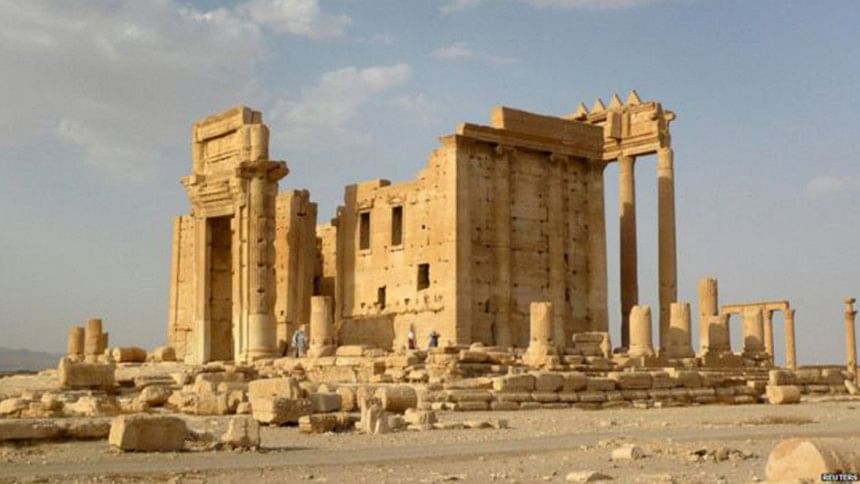UN confirms Palmyra temple destroyed

A satellite image confirms that the main temple in the ancient city of Palmyra in northern Syria has been destroyed, the United Nations says.
There had been earlier reports of an explosion at the Temple of Bel in Palmyra, which is held by militants from the Islamic State (IS) group.
Syria's antiquities chief had earlier said the basic structure of the 2,000-year-old site was intact.
But UN satellite analysts Unosat say the image shows almost nothing remains.
"Unfortunately, the images we acquired do show that the main building of the temple has been destroyed," Einar Bjorgo, Unosat's manager, told the BBC early today.
He added that a set of columns nearby had also been flattened.
A local man, Khaled al-Homsi, told the BBC that only the outer boundary wall and the gateway to the temple remained.
"I'm concerned just like any other Syrian who lives in this country," Homsi said.
"Whenever we hear of these explosions or destructions of important monuments... it's like losing a part of yourself, a part of history, a part of world knowledge."
ANCIENT CITY OF PALMYRA
-- Unesco World Heritage site
-- Site contains monumental ruins of great city, once one of the most important cultural centres of the ancient world
-- Art and architecture, from the 1st and 2nd Centuries, combine Greco-Roman techniques with local traditions and Persian influences
-- More than 1,000 columns, a Roman aqueduct and a formidable necropolis of more than 500 tombs made up the archaeological site
-- More than 150,000 tourists visited Palmyra every year before the Syrian conflict
On Monday, Maamoun Abdul Karim, the head of the Syrian Department of Antiquities and Museums, had said the Temple of Bel suffered a large explosion, but that he believed most of the site had remained intact.
Witnesses had struggled to get close to the site to confirm the extent of the damage.
IS has previously targeted historical sites in areas under its control in Iraq and Syria, regarding their ancient temples and sculptures as heretical.
The sale of looted antiquities is one of the group's main sources of funding. It has also been accused of destroying ancient sites to gain publicity.
Authorities removed hundreds of statues and priceless objects before IS tightened its grip on Palmyra earlier this year.

Last week, it was confirmed that another site at Palmyra, the Temple of Baalshamin, had been blown up.
Unosat released satellite images showing the extent of the damage, proving that parts were heavily damaged or completely destroyed.
IS militants seized control of Palmyra in May, sparking fears for the World Heritage site.
Earlier this month the group murdered 81-year-old Khaled al-Asaad, the archaeologist who had looked after the Palmyra ruins for 40 years.
The world-famous Greco-Roman ruins of Palmyra are in the desert north-east of the Syrian capital, Damascus.
The Temple of Bel is dedicated to the Palmyrene gods and was one of the best-preserved parts of the ancient city.
Syrian government forces have sought to drive IS out of the Palmyra area in recent months and there has been fierce fighting in nearby towns.

 For all latest news, follow The Daily Star's Google News channel.
For all latest news, follow The Daily Star's Google News channel. 



Comments